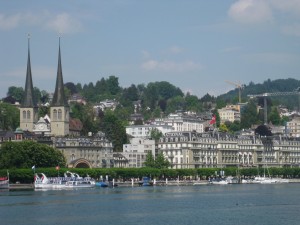The European Broadcast Union held its annual Eurovision TV Summit in May 2011 at the gorgeous KKL Luzern Culture and Convention Centre in Lucerne, Switzerland. (Photos don’t do it justice!)
I was delighted to participate in this year’s program as a speaker in their Common Focus day (a mini TedX-like conference held on the 3rd day of the Summit. The theme for Common Focus was the future of public service broadcasting—something I have been doing research on as a part of my work in education and youth, digital media, and civic engagement. As the EBU described it: “This year the Common Focus Day will have a revamped format and will focus on the future of public service broadcasting, delving into how to engage and entertain new generations in an immersive way.”
I followed 14 year- old Adora Svitak, poet, student, and teacher – who provided the living proof to broadcasters that young people really do inhabit a vibrant digital media ecology and that television has to learn how to find its niche in this world if they want to be relevant in the lives of young people now and in the future.
My task was to talk about youth (the “new” generation)—in the bigger context of digital media and public service. I focused on how young people are experimenting with new forms of active citizenship and social engagement with digital media. I shared some stories about the Harry Potter Alliance and the Prospect Sierra School student Carrot Mobs as examples of young people learning how to push their own boundaries, find the extent of their civic powers, and participate in social transformation using social, digital media. If the European public broadcasters truly want to be public service broadcasters, they need to help young people redefine public service and civic engagement through digital media. The broadcasters need to stop “paving the cow paths” by repurposing broadcast content for the web or add a web-based voting component to their programming and really embrace the digital media ecology and enable young people to create new kinds of publics, citizenship, and new forms of civic action. If public broadcasters do this, they will be a critical part of the future civic infrastructure.
The organizer of the event, the dynamic Nicoletta Iacobacci, and I discussed the profound role that public broadcasters could have in defining what “socially responsible media” could be and how it could drive more widespread social change. Nicoletta is organizing a TedX conference in Rome around the links between socially responsible media and transmedia. It is going to be fantastic so check it out.
Here is a link to all the EBU Eurovision Summit 2011 common focus speaker presentations.
Some highlights for me:
- Maarten Lens-Fitzgerald, CEO of Layar showed several applications of mobile augmented reality and explained how the opening up of new “layers” of reality is creating a new digital and interactive frontier.
- Rob McIntosh provided a really nice framework for thinking about the ecology of screens: small (smart phone), medium (tablet), large (PC), extra large (HDTV). He described how broadcasters need to think about how their content moves across this ecology and how the experience of socialness changes, or can change. He raised some good questions about what high immersion or high interaction can look like and what it can mean for an individual’s or group’s experience.
- Ian Ginn (Hubbub Media/Transmedia Learning Network) reminded us that storytelling has always been immersive. The new thing is that the boundaries and scope of the story world has exploded. Broadcasters need to understand how they can help people become storytellers in communities online and how they can support the development and evolution of stories across media platforms in meaningful ways.
- Orvar Safstrom (Videogame journalist and writer) did a nice wrap up for broadcasters. He started with a comparison to the trench warfare of World War I as an example of technology and innovation outpacing strategy– perhaps a shock to the broadcasters but an apt analogy. A nice statement of his that stuck with me was “let your users take content into their hearts and out into their lives.”


